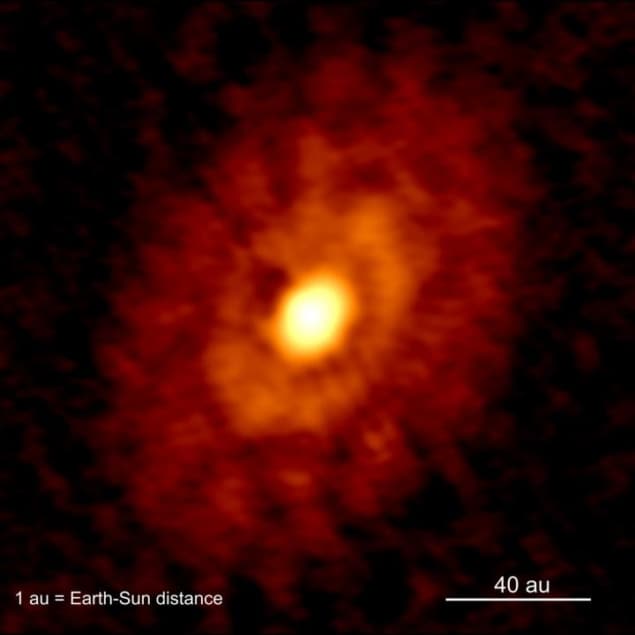
Detailed ring structures have been spotted for the first time in a young star-forming disc. This suggests that planets may form at the same time as their host stars – rather than towards the end of the star formation process. The observation was made by Dominique Segura-Cox at the Max Planck Institute for Extraterrestrial Physics and colleagues and it could offer new clues about how the solar system formed.
Concentric bright rings in the discs surrounding newly forming stars (called protostars) are widely believed to be clear evidence for ongoing planet formation. As nascent planets accrete gas and dust, many theories suggest that they carve out gaps in the disc, creating distinctive radial patterns. So far, these structures have been discovered in abundance around class II protostars, which are about one million years old. These protostars are close to becoming main sequence stars, and often feature discs that have separated into clearly defined rings.
The high contrast between the light and dark regions of these discs suggests that planet formation is already well underway in class II protostar systems. This means that planet formation probably starts earlier on when protostars are still in their class I phase. At this stage, protostars are 100,000s of years old and embedded within thick envelopes of gas and dust.
Using the Atacama Large Millimetre Array (ALMA) radio telescope in Chile, Segura-Cox’s team has found clear evidence for star formation in a disc surrounding the class I protostar IRS 63. This system is in the L1709 interstellar cloud about 470 light-years away.
Two concentric rings
Less than 500,000 years old, IRS 63 is one of the brightest known class I protostars at millimetre wavelengths. Within its disc, the researchers found two distinct concentric rings, together containing dust with a total mass of about half that of Jupiter. The radii of the rings are greater than 20 times the distance between the Earth and Sun. With such large amounts of material, these rings could coalesce into the solid cores of gas-giant planets. As a result, the planets and their star could be forming as “siblings” at the same time.
In addition, Segura-Cox and colleagues showed that the existence of these rings could solve the “radial-drift” problem. As dust particles become bigger, they experience more aerodynamic drag from the gas in the disc. As a result, dust particles are expected to lose angular momentum and fall into the protostar before they can join together to form a planet.

ALMA debuts its high-resolution results
In contrast, the team’s observations suggest that rings with higher dust densities than the rest of the disc could create a series of maxima in gas pressure; efficiently trapping solid material to prevent inspiralling. If planets can form far out around a protostar as young as IRS 63, the team say that that radial drift is not a problem.
Since IRS 63 has a similar size and mass to the solar system, it may also offer astronomers a rare glimpse into how our own planetary neighbours first formed. For example, Jupiter’s core could have formed at about six times its current distance from the Sun, before migrating inwards.
The research is described in Nature.



